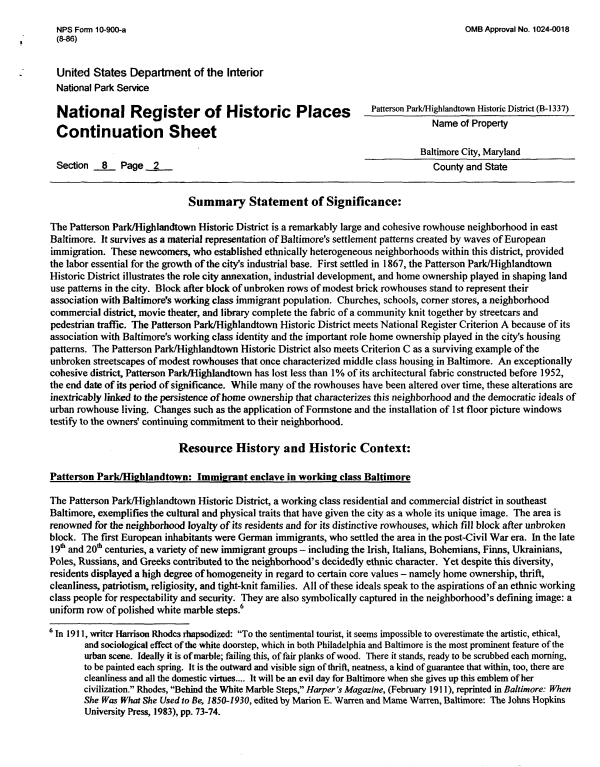 |
||||
|
DEPARTMENT OF HOUSING AND COMMUNITY DEVELOPMENT, MARYLAND HISTORICAL TRUST (Historic Sites Survey) var.d. MSA SE16-3 Image No: se16-3-0097 Enlarge and print image (92K) |
 |
||||
|
DEPARTMENT OF HOUSING AND COMMUNITY DEVELOPMENT, MARYLAND HISTORICAL TRUST (Historic Sites Survey) var.d. MSA SE16-3 Image No: se16-3-0097 Enlarge and print image (92K) |
| NPS Form 1 0-900-a OMB Approval No. 1 024-001 8 (846) United States Department of the Interior National Park Service pattern park/Highiandtown Historic District (8- National Register of Historic Places r* -• -• *»• A. Name of Property Continuation Sheet Baltimore City, Maryland Section 8 Page 2_ County and State Summary Statement of Significance: The Patterson Park/Highiandtown Historic District is a remarkably large and cohesive rowhouse neighborhood in east Baltimore. It survives as a material representation of Baltimore's settlement patterns created by waves of European immigration. These newcomers, who established ethnically heterogeneous neighborhoods within this district, provided the labor essential for the growth of the city's industrial base. First settled in 1867, the Patterson Park/Highiandtown Historic District illustrates the role city annexation, industrial development, and home ownership played in shaping land use patterns in the city. Block after block of unbroken rows of modest brick rowhouses stand to represent their association with Baltimore's working class immigrant population. Churches, schools, corner stores, a neighborhood commercial district, movie theater, and library complete the fabric of a community knit together by streetcars and pedestrian traffic. The Patterson Park/Highiandtown Historic District meets National Register Criterion A because of its association with Baltimore's working class identity and the important role home ownership played in the city's housing patterns. The Patterson Park/Highiandtown Historic District also meets Criterion C as a surviving example of the unbroken streetscapes of modest rowhouses that once characterized middle class housing in Baltimore. An exceptionally cohesive district, Patterson Park/Highiandtown has lost less than 1% of its architectural fabric constructed before 1952, the end date of its period of significance. While many of the rowhouses have been altered over time, these alterations are inextricably linked to the persistence of home ownership that characterizes this neighborhood and the democratic ideals of urban rowhouse living. Changes such as the application of Formstone and the installation of 1st floor picture windows testify to the owners' continuing commitment to their neighborhood. Resource History and Historic Context: Patterson Park/Highiandtown: Immigrant enclave in working class Baltimore The Patterson Park/Highiandtown Historic District, a working class residential and commercial district in southeast Baltimore, exemplifies the cultural and physical traits that have given the city as a whole its unique image. The area is renowned for the neighborhood loyalty of its residents and for its distinctive rowhouses, which fill block after unbroken block. The first European inhabitants were German immigrants, who settled the area in the post-Civil War era. In the late 19th and 20th centuries, a variety of new immigrant groups — including the Irish, Italians, Bohemians, Finns, Ukrainians, Poles, Russians, and Greeks contributed to the neighborhood's decidedly ethnic character. Yet despite this diversity, residents displayed a high degree of homogeneity in regard to certain core values - namely home ownership, thrift, cleanliness, patriotism, religiosity, and tight-knit families. All of these ideals speak to the aspirations of an ethnic working class people for respectability and security. They are also symbolically captured in the neighborhood's defining image: a uniform row of polished white marble steps.6 6 In 1911, writer Harrison Rhodes rhapsodized: "To the sentimental tourist, it seems impossible to overestimate the artistic, ethical, and sociological effect of the white doorstep, which in both Philadelphia and Baltimore is the most prominent feature of the urban scene. Ideally it is of marble; failing this, of fair planks of wood. There it stands, ready to be scrubbed each morning, to be painted each spring. It is me outward and visible sign of thrift, neatness, a kind of guarantee that within, too, there are cleanliness and all the domestic virtues.... It will be an evil day for Baltimore when she gives up this emblem of her civilization." Rhodes, "Behind the White Marble Steps," Harper's Magazine, (February 1911), reprinted in Baltimore: When She Was What She Used to Be, 1850-1930, edited by Marion E. Warren and Mame Warren, Baltimore: The Johns Hopkins University Press, 1983), pp. 73-74. |